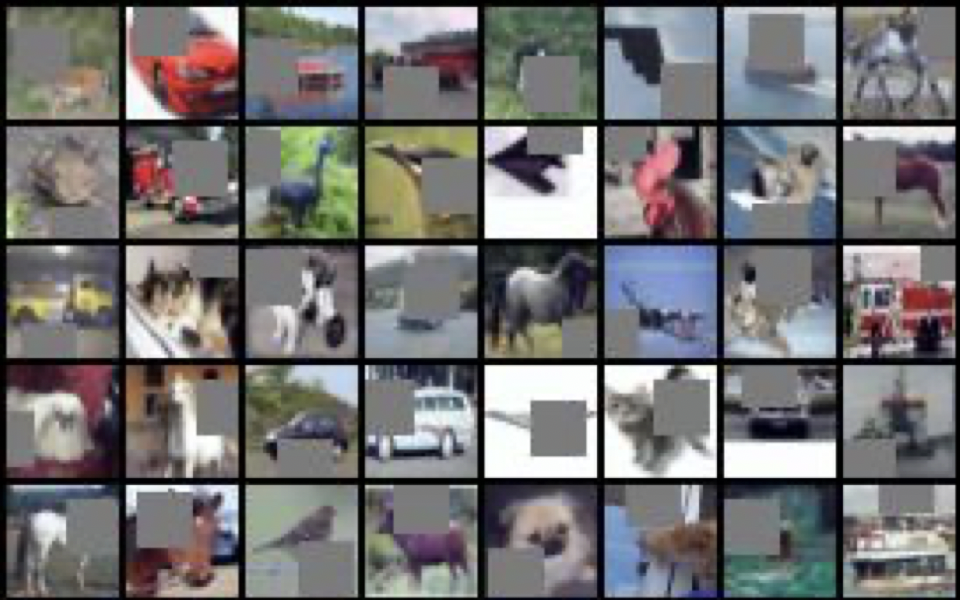Cutout

From Improved Regularization of Convolutional Neural Networks with Cutout by DeVries and Taylor, 2017.
Tags: Vision, Increased CPU Usage, Increased Accuracy, Method, Augmentation, Regularization
TL;DR
Cutout is a regularization/data augmentation technique that works by masking out one or more square regions of an input image.
Attribution
Improved Regularization of Convolutional Neural Networks with Cutout by Terrance DeVries and Graham W. Taylor. Posted to arXiv in 2017.
Applicable Settings
Cutout is a data augmentation technique for images, and hence it is only applicable to vision tasks. Though our implementation does not yet support other modalities, similar methods may prove fruitful (Improving Deep-learning-based Semi-supervised Audio Tagging with Mixup).
Hyperparameters
n_holes- The number of patches of the image to remove.length- The side length of each square patch that is removed.
Example Effects
Cutout incurs a small extra computational cost. Because it is a regularizer it may improve or degrade accuracy, depending on the setting. We found it to be an effective way of improving accuracy in the absence of robust hyperparameter tuning and other regularizers. As we improved our training methodology elsewhere, the benefits from Cutout became negligible.
Implementation Details
Cutout works by randomly choosing one or more square regions from an input image and replacing them with the mean value over the dataset. Since it is common to normalize image data based on the dataset mean and variance, the mean value is typically 0. To ease implementation, we went with a simple binary mask. Cutout is most efficiently applied to a batch of images, so each image in the batch has the same regions modified. This lets us easily run the augmentation on the GPU, if one is available.
Our implementation is based on that of Terrance DeVries as posted on GitHub.
Suggested Hyperparameters
n_holes = 1Typically removing a single patch gives good results.length = int(0.5 * image_size)Typically a square with a side length of half the image size produces good results. However, in some scenarios this may be too large, in which caselength = int(0.25 * image_size)might be better.
Considerations
As Cutout runs on GPU by default and uses some extra memory to construct the mask, out of memory errors may occur if GPU memory is severely limited.
Also, since Cutout masks a portion of the input, this can alter the inherent shape/texture bias. For an example, see The Origins and Prevalence of Texture Bias in Convolutional Neural Networks.
Composability
As general rule, combining regularization-based methods yields sublinear improvements to accuracy. This also includes Cutout. For example, we do not see improvements when combined with other regularization/augmentation methods such as Mixup and Label Smoothing.
Code
- class composer.algorithms.cutout.CutOut(n_holes: int, length: int)[source]
Cutout is a data augmentation technique that works by masking out one or more square regions of an input image.
This implementation cuts out the same square from all images in a batch.
- Parameters
X (Tensor) – Batch Tensor image of size (B, C, H, W).
n_holes – Integer number of holes to cut out
length – Side length of the square hole to cut out.
- apply(event: composer.core.event.Event, state: composer.core.state.State, logger: composer.core.logging.logger.Logger) Optional[int][source]
Apply cutout on input images
- match(event: composer.core.event.Event, state: composer.core.state.State) bool[source]
Runs on Event.AFTER_DATALOADER
- composer.algorithms.cutout.cutout(X: torch.Tensor, n_holes: int, length: int) torch.Tensor[source]
See
CutOut.- Parameters
X (Tensor) – Batch Tensor image of size (B, C, H, W).
n_holes – Integer number of holes to cut out
length – Side length of the square hole to cut out.
- Returns
X_cutout – Image with n_holes of dimension length x length cut out of it.